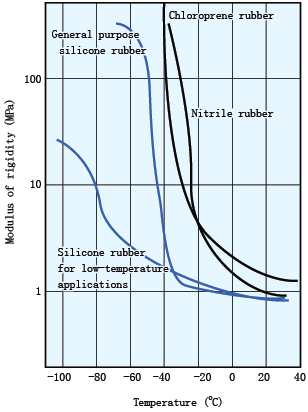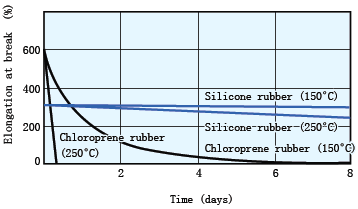| |
|
|
|
| HEAT AND COLD RESISTANCE |
|
Silicone rubber withstands high and low temperatures far better than organic rubbers. Silicone rubber can be used indefinitely at 150∑C with almost no change in its properties. It withstandsuse even at 200∑C for 10,000 hours or more, and some products can withstand heat of 350∑C for short periods.components used in high temperature environments.Silicone rubber also has excellent resistance to cold temperatures. The embrittlement point of typical organic rubbers is between -20∑and -30∑C, compared to -60∑to -70∑C for silicone rubbers. Even at temperatures at which organic rubbers turn brittle, silicone rubber remains elastic. Someproducts withstand extremely low temperatures of -100∑C and below.
Generally speaking, silicone rubber hardens when heated in air, with decreasing elongation as it deteriorates; but in sealed conditions it softens as it deteriorates, and its operating life at high temperatures is shorter in sealed conditions than in air. This softening results from the degradation of the siloxanepolymer. Adjusting the silicone rubber formula, using a different curing agent, and/or post-curing can help prevent softening in hot, sealed conditions. Such products are also available. |
|
| Low-temperature properties of various rubbers |
| <Test method> JIS K 6261, Section 5 |
| |
 |
|
| Comparison of high-temperature operating life |
| Chloroprene rubber vs. silicone rubber |
|
 |
| Chloroprene rubber deteriorates rapidly and discolors at temperatures |
| between 150∑-250∑C, but there is little change in silicone rubber even at 250∑C. |
|
|
|